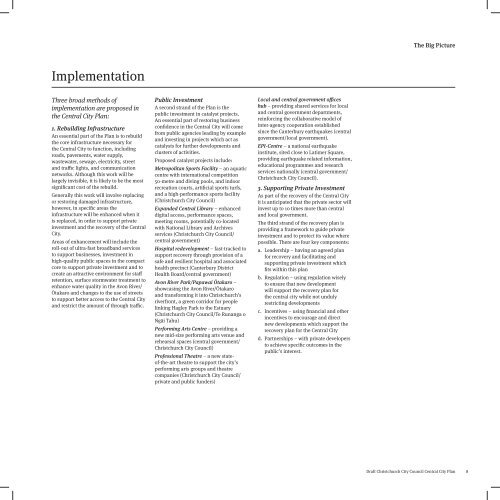Draft plan - Stuff
Draft plan - Stuff
Draft plan - Stuff
Create successful ePaper yourself
Turn your PDF publications into a flip-book with our unique Google optimized e-Paper software.
The Big Picture<br />
Implementation<br />
Three broad methods of<br />
implementation are proposed in<br />
the Central City Plan:<br />
1. Rebuilding Infrastructure<br />
An essential part of the Plan is to rebuild<br />
the core infrastructure necessary for<br />
the Central City to function, including<br />
roads, pavements, water supply,<br />
wastewater, sewage, electricity, street<br />
and traffic lights, and communication<br />
networks. Although this work will be<br />
largely invisible, it is likely to be the most<br />
significant cost of the rebuild.<br />
Generally this work will involve replacing<br />
or restoring damaged infrastructure,<br />
however, in specific areas the<br />
infrastructure will be enhanced when it<br />
is replaced, in order to support private<br />
investment and the recovery of the Central<br />
City.<br />
Areas of enhancement will include the<br />
roll-out of ultra-fast broadband services<br />
to support businesses, investment in<br />
high-quality public spaces in the compact<br />
core to support private investment and to<br />
create an attractive environment for staff<br />
retention, surface stormwater treatment to<br />
enhance water quality in the Avon River/<br />
Ōtakaro and changes to the use of streets<br />
to support better access to the Central City<br />
and restrict the amount of through traffic.<br />
Public Investment<br />
A second strand of the Plan is the<br />
public investment in catalyst projects.<br />
An essential part of restoring business<br />
confidence in the Central City will come<br />
from public agencies leading by example<br />
and investing in projects which act as<br />
catalysts for further developments and<br />
clusters of activities.<br />
Proposed catalyst projects include:<br />
Metropolitan Sports Facility – an aquatic<br />
centre with international competition<br />
50-metre and diving pools, and indoor<br />
recreation courts, artificial sports turfs,<br />
and a high-performance sports facility<br />
(Christchurch City Council)<br />
Expanded Central Library – enhanced<br />
digital access, performance spaces,<br />
meeting rooms, potentially co-located<br />
with National Library and Archives<br />
services (Christchurch City Council/<br />
central government)<br />
Hospital redevelopment – fast-tracked to<br />
support recovery through provision of a<br />
safe and resilient hospital and associated<br />
health precinct (Canterbury District<br />
Health Board/central government)<br />
Avon River Park/Papawai Ōtakaro –<br />
showcasing the Avon River/Ōtakaro<br />
and transforming it into Christchurch’s<br />
riverfront, a green corridor for people<br />
linking Hagley Park to the Estuary<br />
(Christchurch City Council/Te Runanga o<br />
Ngāi Tahu)<br />
Performing Arts Centre – providing a<br />
new mid-size performing arts venue and<br />
rehearsal spaces (central government/<br />
Christchurch City Council)<br />
Professional Theatre – a new stateof-the-art<br />
theatre to support the city’s<br />
performing arts groups and theatre<br />
companies (Christchurch City Council/<br />
private and public funders)<br />
Local and central government offices<br />
hub – providing shared services for local<br />
and central government departments,<br />
reinforcing the collaborative model of<br />
inter-agency cooperation established<br />
since the Canterbury earthquakes (central<br />
government/local government).<br />
EPI-Centre – a national earthquake<br />
institute, sited close to Latimer Square,<br />
providing earthquake related information,<br />
educational programmes and research<br />
services nationally (central government/<br />
Christchurch City Council).<br />
3. Supporting Private Investment<br />
As part of the recovery of the Central City<br />
it is anticipated that the private sector will<br />
invest up to 10 times more than central<br />
and local government.<br />
The third strand of the recovery <strong>plan</strong> is<br />
providing a framework to guide private<br />
investment and to protect its value where<br />
possible. There are four key components:<br />
a. Leadership – having an agreed <strong>plan</strong><br />
for recovery and facilitating and<br />
supporting private investment which<br />
fits within this <strong>plan</strong><br />
b. Regulation – using regulation wisely<br />
to ensure that new development<br />
will support the recovery <strong>plan</strong> for<br />
the central city while not unduly<br />
restricting developments<br />
c. Incentives – using financial and other<br />
incentives to encourage and direct<br />
new developments which support the<br />
recovery <strong>plan</strong> for the Central City<br />
d. Partnerships – with private developers<br />
to achieve specific outcomes in the<br />
public’s interest.<br />
<strong>Draft</strong> Christchurch City Council Central City Plan<br />
8
















